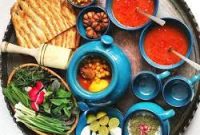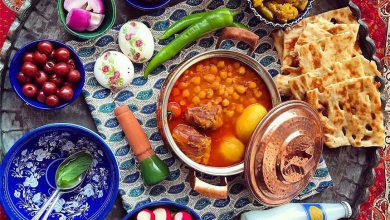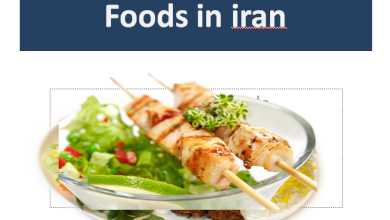Do you want to know the specialty of Iranian food and its benefits?
specialty of Iranian food
Specialty of Iranian food:
Iranian cuisine is unique because of the distinct fusion of flavors, ingredients, and cooking techniques that are used there. Iran is renowned for its extensive and varied culinary heritage. Here are a few traits that make Iranian food distinctive:
Use of Herbs: Iranian cooking commonly makes use of fresh herbs such parsley, cilantro, mint, dill, and fenugreek. In addition to flavor, these herbs impart a particular freshness to meals.
Iran is one of the top producers of saffron, a spice that is frequently used in Persian cuisine. Saffron adds a subtle flavor, vibrant color, and distinct floral aroma to a variety of meals, notably rice.
Iranian cuisine is recognized for its intricate flavor harmonies. Dishes usually strike a balance between sweet and sour notes thanks to ingredients like pomegranate molasses, dried limes, and barberries that add to the richness of flavors.
Iranians are experts at cooking rice so that the coveted “Tahdig,” or crispy rice crust, forms at the bottom of the pot. Iranian rice dishes are known for having this crunchy top layer, which is considered as a delicacy and distinctive quality.
Kebabs: The skillful preparation of kebabs is a renowned culinary legacy in Iran. These skewered and grilled meats, which are typically flavored with saffron and other seasonings, are quite popular among Iranians.
Slow-cooked dinners made of meat, vegetables, herbs, and exotic items like dried limes and dates are known as khoresht in Persian.
Rosewater, sumac, barberries, and dried limes are uncommon ingredients used in Persian cuisine that may not be as common in other cuisines. These elements contribute to the uniqueness of Iranian food.
Iranian meals are regularly shared with others, and there are customs and etiquette associated with dining there as well. For example, offering tea as a sign of welcome and sharing food family-style are both culinary traditions.
Regional Variations: There are numerous distinct regional cuisines in Iran as a result of its vast territory and diverse topography. Each locale has its own specialty cuisine and unique ingredients depending on what is readily accessible locally.
Iranian cuisine focuses a significant emphasis on using foods that are both fresh and in season. When fruits, vegetables, and herbs are at their most flavorful, it is the perfect time to use them.
Sweets & Desserts: Persian desserts are sweet indulgences that typically contain nuts, rosewater, cardamom, and saffron. Traditional sweets including baklava, gaz, zoolbia, and bamieh are popular snacks.
Lean meats, whole grains, and legumes can be included in many Iranian dishes to help maintain a balanced and nutritious diet.
In addition to having distinctive flavors, Iranian cuisine is distinctive overall due to the cultural significance of its culinary traditions and the emphasis placed on hospitality.

Iranian food benefits:
Iranian food, like many other traditional cuisines, provides a number of potential health benefits when incorporated into a balanced diet.
Here are a few potential benefits of Iranian cuisine:
Rich in Nutrients: Iranian food commonly uses fresh herbs, fruits, vegetables, and lean proteins. This diversity of components can offer a wide range of essential elements, such as vitamins, minerals, and dietary fiber.
Saffron, turmeric, and other herbs are used in many Iranian cuisines because they are antioxidant-rich and have other health benefits as well. Antioxidants help protect cells from free radical damage and may be good for overall health.
Iranian food does contain fats, however they are typically preferred to saturated and trans fats by utilizing olive oil, almonds, and seeds as a substitute.
Whole Grains: Rice is a staple in Iranian cuisine and provides essential nutrients, dietary fiber, and sustained energy when cooked with all of its grains.
Lean proteins: A staple of Iranian cuisine are grilled or stewed meats and kebabs. When made with minimal added oil, these recipes can provide high-quality protein while being relatively low in saturated fat.
Legume: In Iranian cooking, legumes including lentils, chickpeas, and kidney beans are frequently used. Legumes offer a good supply of plant-based protein in addition to fiber, vitamins, and minerals.
Herbs and Spices: Cumin, turmeric, mint, cilantro, and dill are just a few of the herbs and spices used in Iranian cuisine. In addition to enhancing flavor, these additions may also
Fermented Foods: Yogurt-based dishes like Mast-o-Khiar and Kashk-e Bademjan are a staple of Iranian cuisine. These fermented foods’ probiotics have advantageous impacts on intestinal health.
Iranians frequently dine family-style, which might encourage moderation in portion sizes and aid in preventing overeating.
Benefits of Tea: Drinking tea, typically flavored with herbs like cardamom or mint, is a popular practice that can provide a relaxing and antioxidant-rich beverage alternative.
It’s important to keep in mind that whether Iranian food has any health benefits depends on the choices made within the cuisine.
The majority of the ingredients and cooking methods used in traditional foods are healthful, but modern versions may include unhealthy products or procedures that might negate these benefits. Conscious eating and quantity control are also essential for sustaining a balanced diet.
It is recommended to consume Iranian food in moderation, combine it with a variety of other nutrient-dense meals, and take into account each person’s dietary preferences and limitations in order to achieve the greatest health outcomes.



